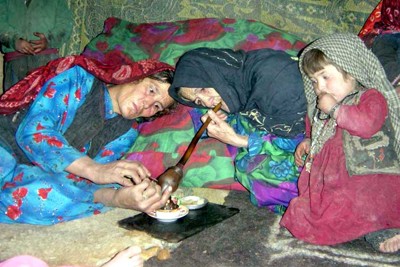
http://www.rawa.org/images/opium_women.jpg

http://media.thestar.topscms.com/images/10/5b/8d201a8542228e15fe6df7824931.jpeg
The revelation that the number of opium-addicted Afghan children has reached new highs is a sad unintended consequence of that war. It dramatically illustrates how adult war games can doom generations of children to a miserable life.
A group of researchers hired by the US State Department found staggering levels of opium in Afghan children, some as young as 14 months old, who had been passively exposed by adult drug users in their homes. In 25% of homes where adult addicts lived, children tested showed signs of significant drug exposure, according to the researchers. According to one of the researchers the children exhibit the typical behavior of opium and heroin addicts. If the drug is withdrawn they go through a withdrawal process.
The results of the study should sound an alarm, since not only were opium products found in indoor air samples but also their concentrations were extremely high. This suggests that, as with second-hand cigarette smoke, contaminated indoor air and surfaces pose a serious health risk to women and children’s health.
The extent of health problems in children as a result of such exposure is not known. What is known is that the number of drug users has increased from 920,000 in 2005 to over 1.5 million, according to Zalmai Afzali, the spokesman for the Ministry of Counter-Narcotics (MCN) in Afghanistan. A quarter of those users are thought to be women and children. Afzali stated that Afghanistan could become the world’s top drug-using nation per capita if current trends continue.
According to the UN Office on Drugs and Crime (UNODC) no other country in the world produces as much heroin, opium, and hashish as Afghanistan, a sad distinction for a country already ravaged by war. This may explain why control efforts so far have been concentrated on poppy eradication and interdiction to stem exports with less attention paid to the rising domestic addiction problem, particularly in children.
Both American and Afghan counter narcotic officials have said that such widespread domestic drug addiction is a relatively new problem. Among the factors leading to increased levels of drug use is the high unemployment rate throughout the country, the social upheaval provoked by this war and those that preceded it and the return of refugees from Iran and Pakistan who became addicts while abroad.
Those who are injecting drug users face the additional risk of HIV-infection through the sharing of contaminated syringes. “Drug addiction and HIV/AIDS are, together, Afghanistan’s silent tsunami,” declared Tariq Suliman, director of the Nejat’s rehabilitation center to the UN Office for Humanitarian Affairs. There are about 40 treatment centers for addicts dispersed throughout the country but most are small, poorly staffed and under-resourced.
For the first time ever, an international team including World Health Organization (WHO) officials and experts from Johns Hopkins University and the Medical University of Vienna has joined efforts to design a treatment regime for young children.
The U.S. and its allies have the resources to rapidly expand and adequately fund and resource such treatment and rehabilitation centers throughout the country. Anything less will be yet another serious indictment of an occupation gone astray.
.
No comments:
Post a Comment